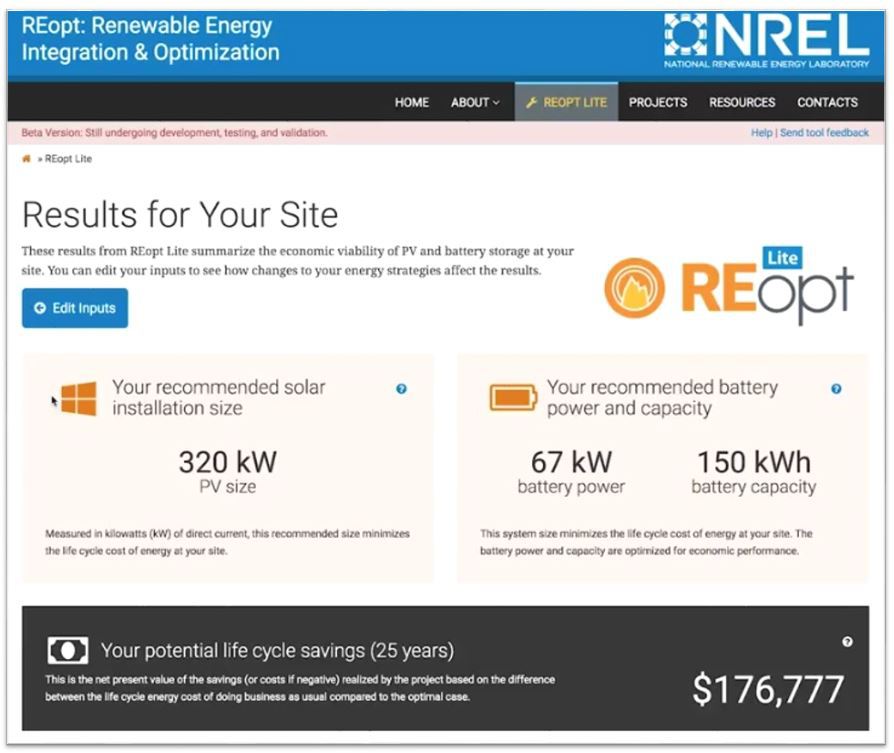June 25, 2018
How Could Solar+Storage Benefit Your Community? Find Out for Free.
By Seth Mullendore

Sample results
A new release of the National Renewable Energy Laboratory’s (NREL) free online tool allows anyone to enter in a building’s information to estimate how much solar PV and battery storage (solar+storage) capacity would be needed to keep critical loads powered during an emergency.
The REopt™ Lite web tool is designed to assist users such as building owners, energy managers and community planners in:
- evaluating the economic viability of grid-connected PV and battery storage at a site,
- identifying system sizes and operational strategies to minimize energy costs, and
- determining system sizes that can sustain critical loads through a specified outage period.
The tool’s newly enhanced features let users quickly evaluate the costs and benefits of a solar+storage system optimized to power essential services – like lighting, refrigeration, and communications – when the grid goes down. These expanded capabilities mark the first time that resilience and economic goals for installing solar+ storage can be compared and balanced within the same easy-to-use interface.
The tool allows users to evaluate solar+storage for any commercial building, including businesses, schools, public facilities, and multifamily housing. All that’s required to get started is some basic information about the building, like its location and electricity rates.
With this information, and the ability to add and fine-tune many other additional details, REopt Lite calculates and estimates the optimal solar+storage system sizing to meet two main design objectives:
- Financial benefits. Though a number of tools can evaluate the economic benefits of solar, adding storage into the equation makes things much more complicated. For most commercial customers, the main economic benefit of adding battery storage is to reduce demand charges. Demand charges typically range anywhere from 30 to 70 percent of a monthly utility bill for commercial customers, from local community centers to giant data centers. Unlike solar and efficiency measures, batteries can directly target and manage periods of high electricity demand, resulting in significant customer savings. As an example, Walmart has been using battery storage to cut costs since 2013.
- Resilience benefits. Meeting resiliency goals is also a concern to many building owners. Recent disasters in places such as Florida and Puerto Rico, where widespread outages contributed to devastating loss of life, have underscored how important it is to give building owners and emergency planners straightforward tools to evaluate how to make buildings more resilient. By installing solar+ storage, buildings can keep critical loads powered when the grid goes down. While it can be difficult to put a value on improved resilience, there is a clear benefit in allowing a business to stay open; enabling residents to shelter in place; and, in the case of facilities like medical clinics and emergency shelters, keeping equipment functioning to potentially prevent loss of life.
Instead of having to design a system for economics and resilience independently, REopt Lite now lets users evaluate these sometimes conflicting goals in a simple, side-by-side comparison. Users can start by designing a system that maximizes savings and then look at the resilience the system could provide, or start by meeting resilience goals and seeing where the economic gap may be.
The REopt Lite tool also gives users the ability to assign and adjust a value representing avoided outages. With this added feature, it’s possible to evaluate what the benefit of improved resilience may be worth to a building owner or community. Another new feature lets users incorporate existing on-site generation, like a diesel generator, into their resilient design evaluation.
These and other enhanced resilience capabilities were developed in collaboration with Clean Energy Group through its Resilient Power Project and supported with funding from The Kresge Foundation and the Department of Energy’s Federal Energy Management Program and Solar Energy Technologies Office.
On July 25th, Clean Energy Group will host a free webinar with NREL to walk through a real-world example of how the tool can be used to optimize and evaluate a resilient solar and battery storage installation. More information about the webinar can be found at www.cleanegroup.org/webinar/simplifying-resilient-power-design-with-reopt-lite.
This blog post was also published in Renewable Energy World.














